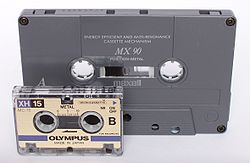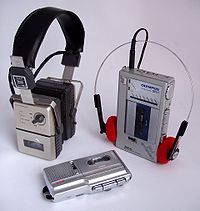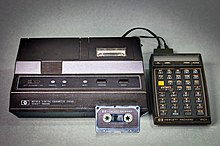Microcassette
This articleneeds additional citations forverification.(July 2022) |
 A Microcassette is significantly smaller than aCompact Cassette | |
| Media type | Magnetic cassette tape |
|---|---|
| Encoding | Analog signal |
| Capacity | MC60 (30 min per side at 2.4 cm/s) MC10 MC15 MC30 |
| Readmechanism | Tape head |
| Writemechanism | Magneticrecording head |
| Developedby | Olympus |
| Usage | Dictation,audio storage |
TheMicrocassette(often written generically asmicrocassette) is anaudio storagemedium, introduced byOlympusin 1969.
It has the same width ofmagnetic tapeas theCompact Cassettebut in a cassette roughly one quarter the size. By using thinner tape and half or a quarter the tape speed, microcassettes can offer comparable recording time to the compact cassette but in a smaller package.[citation needed]
History
[edit]
Top left, stereoheadphoneswith a cassette player built into one side.
Top right, a portable cassette player and audio recorder with radio for use with headphones.
Below, a miniaturedictation machinemainly for business dictations, use by journalists, etc. The latter is far more widely used than the other two types, which were rather rare.


Microcassettes have mostly been used for recordingvoice.In particular, they are commonly used indictation machinesandanswering machines.Microcassettes have also been used incomputer data storageand to recordmusic.For the latter purpose, devices for recording instereowere produced in 1982 and, forhigher fidelity,microcassettes using Type IV ( "metal", i.e. coated with pure metal particles rather than oxide) tape were sold. This was an attempt by Olympus to cash in on the burgeoningWalkmanmarket; one model, the Olympus SR-11, had a built-in radio and offered a stereo tie-clip microphone as an accessory, which made the unit somewhat popular with concert-goers who wanted to record the concerts they attended without drawing attention to themselves with larger, bulkier full-sized cassette recorders.[citation needed]
Both of these "high-fidelity" microcassette recorders and the special Type IV blanks they required were relatively expensive and of limited availability, so the system was not widely adopted and Olympus phased them out after two years on the market. (Battery life also was a problem, because the high bias currents required by Type IV tape, combined with the state of battery technology at the time, meant that brand-new alkaline batteries might give out in two hours when the unit was in recording mode.) "Standard" microcassettes are still used in theunderground-musiccircuits for recording[1]and distributing[2]experimental musicandfield recordings/sound collage,mostly because of theirlo-fiqualities. As of August 2021, Ohm Electric still produces microcassette tapes.[3]
Specifications
[edit]The original standard microcassette, the MC60, gives 30 minutes recording per side at its standard speed of 2.4 cm/s, and double that duration at 1.2 cm/s; an MC90, giving 45 minutes per side @ 2.4 cm/s, is also available from a few manufacturers. Unlike the Compact Cassette, a choice of recording speeds was provided on the original recorders and many others; the tape also spools in the opposite direction, from right to left. For transcription purposes, continuously variable speed was provided on many players. Microcassettes equalisation time constant: Type I (Ferric) at 200μs and Type IV (Metal) at 120μs.[citation needed]
Competitors
[edit]
The microcassette was beaten to market by theMini-Cassette,introduced byPhilipsin 1967. The mini-cassette is almost identical in appearance and dimensions to the microcassette, however it has thicker cogs for its reels and a slightly wider cassette. The mini-cassette, despite making it to market first, was less successful than the microcassette.[citation needed]
A couple of products were created to compete with the microcassette.DictaphoneandJVCintroduced thepicocassettein 1985, which is half the size of the microcassette. In 1992,Sonyreleased theNTmemo recording system, which employs a small cassette fordigitalrecording.[citation needed]
See also
[edit]- inches per secondandaudio tape length and thicknessfor comparisons with other media.
- Mini-Cassette
- Picocassette
- NT (cassette)
